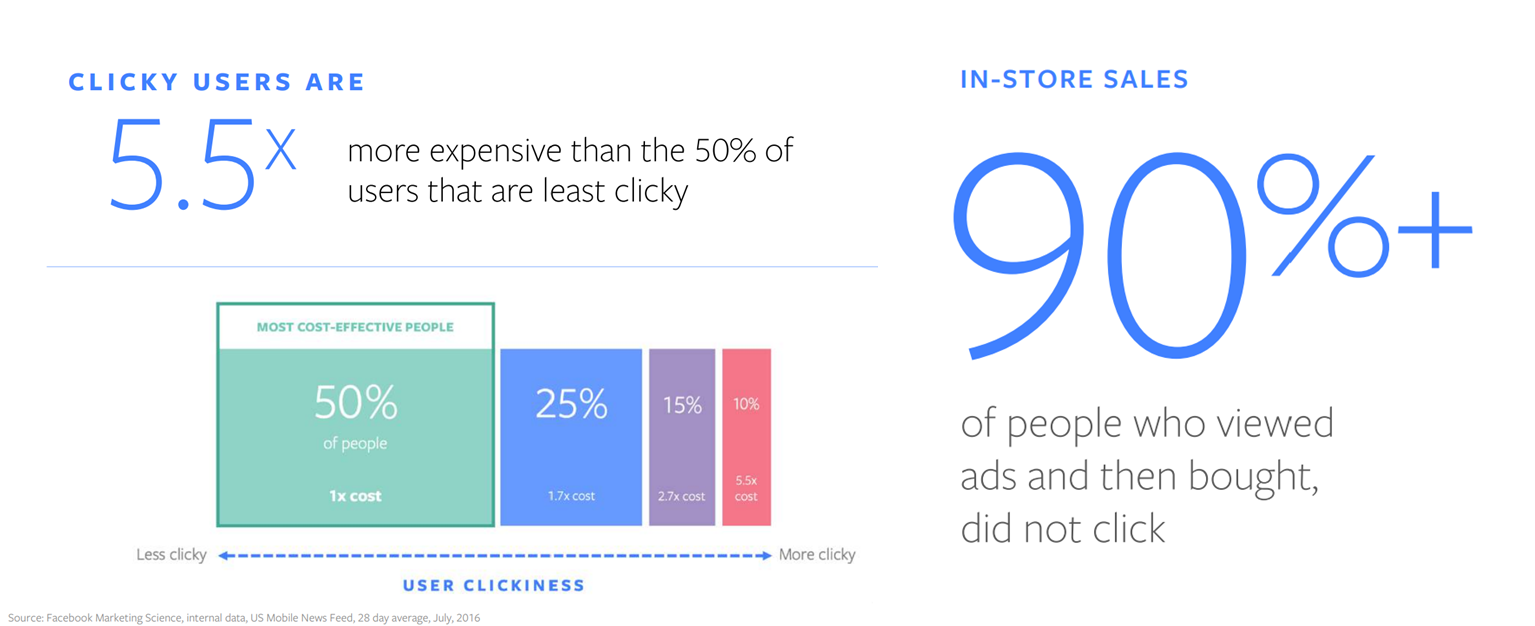Turning Up the Bull*#$% Meter
I did a search on the Agitator/DonorVoice blog for “engagement” and found a post in the way back machine from 2009. Tom Belford wrote the post. Tom is uber smart, dry witted, curmudgeonly and with a bullshit meter purposefully tuned to the highest sensitivity. So, it’s saying something that the post was touting the merits of social media. But it was based on a credentialed, researched, report boldly stating, “social media engagement = $”.
Today, Facebook’s own data from a company in the business of selling “Engagement” says you pay a boatload more to reach people who “engage” (i.e. click a lot) but don’t give you money. Supporting evidence shows zero correlation between clicks and ad recall, brand awareness and purchase intent.

What’s a fundraiser/marketer to do? Rest assured, Facebook is still making a strong case you advertise with them, and their supporting evidence shows a solid to great return on investment. But the only way to see that ROI is by paying attention to “non-engaged”. If you only measure straight-line (click-through) attribution, you quite possibly come to the exact wrong conclusion.
Fundraising is hard. You’re trying to get humans to part with their money, repeatedly, with little to no tangible benefit and enjoy it. And with that, I’ll end by channeling my inner Tom and with my bullshit meter dialed to 11.
- The biggest effect of direct marketing – digital advertising, direct mail, F2F acquisition, telefundraising, social media – is indirect, it creates brand impressions, builds (destroys) brand equity and increases (decreases) donation intent.
- The money raised in the short-term is only partially seen if you only look at the direct, straight line.
- No proxy metric is good but often better than nothing but sometimes worse
- Your best digital donors are your direct mail recipients and you’re probably way sub-optimum in filling that revenue line by sending them a BRE and reply form designed for a behavior they’ll never do.
- Direct mail isn’t dying nor is digital nor is whatever channel comes next or last
- But the way you measure and evaluate a channel could very prematurely pronounce a healthy patient, dead
- No attribution model or gee-whiz AI blackbox is perfect or even close in calibrating the messy world into simple answers
- No channel is better or worse than any other, just different
- No amount of chicken-egg torture or clicking your heels three times or saying it over and over will make multichannel or, shoot me, “omnichannel” marketing a remotely useful concept to growing your brand
- Just being in a channel doesn’t mean you’re doing it well and doing more of it will eventually make your short-term metrics worse. Diminishing returns are undefeated.
- Doing multiple channels at once or all channels simultaneously is not a magic elixir, there is probably a fair amount of waste. And diminishing returns show up at channel level, five channels isn’t better than three.
- All charities have or will quickly reach a point (if small or start-up) where you cannot grow your brand (Reach, Awareness, Share of Wallet Brand Equity, Donation Intent) with short-term, direct response fundraising alone.
- You must do brand mkt to grow in the medium and long-term.
- Impressions matter, a lot. And as it turns out, not just in brand ads but in direct response too.
- Impression metrics are a proxy for attention. It’s far from perfect but buying on CPM is much cheaper than cost per action
- Channel and brand and fundraising and metrics are not strategy, they’re all parts of execution
- If you think you have a “digital strategy”, you’re doing strategy wrong
- “Going after younger donors” could qualify as strategy, just not a good one
- We talk way too much about execution, very little about strategy
Kevin



Kevin, do you have a longer article on your thoughts around multi-channel marketing? I’d like to dive deeper there.
Hi John, the slightly extended thought is that channel is proxy for modality (e.g. long/short, video/still image, audio/written) and a pretty good one at that since channels have innate modality built in – letters are longer form than ads, phone call is different modality than email.
Different modes (channel as proxy) helps reduce irritation from frequency – same message in different mode/channel gets processed differently. Research from huge dataset of real mkt shows 3-4 modes/channels for given campaign is goldilocks effect.
slightly fuller post is here, https://agitator.thedonorvoice.com/death-to-channels-long-live-channels/. Happy to chat further if you’d like, just drop me a line, kschulman@thedonorvoice.com.